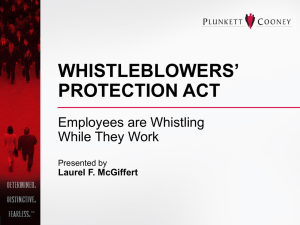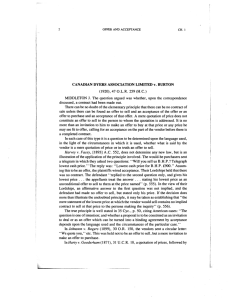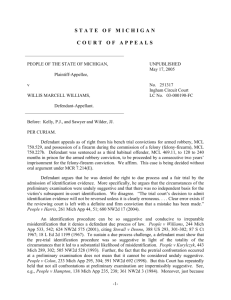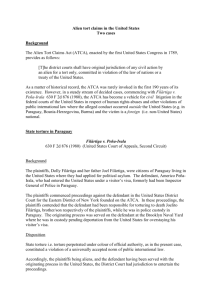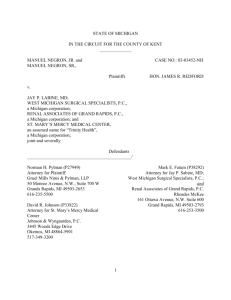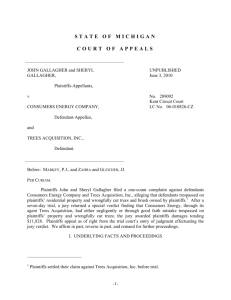COA 250953 CALVIN EVERITT V MARK WILLIAMS Opinion
advertisement
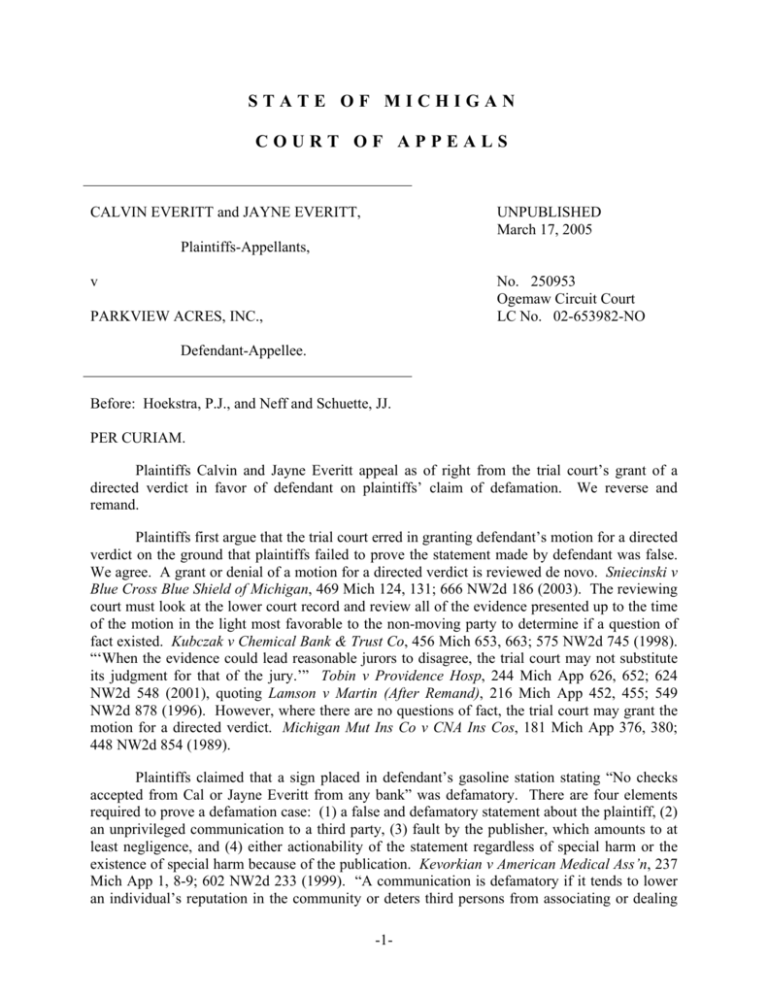
STATE OF MICHIGAN COURT OF APPEALS CALVIN EVERITT and JAYNE EVERITT, UNPUBLISHED March 17, 2005 Plaintiffs-Appellants, v No. 250953 Ogemaw Circuit Court LC No. 02-653982-NO PARKVIEW ACRES, INC., Defendant-Appellee. Before: Hoekstra, P.J., and Neff and Schuette, JJ. PER CURIAM. Plaintiffs Calvin and Jayne Everitt appeal as of right from the trial court’s grant of a directed verdict in favor of defendant on plaintiffs’ claim of defamation. We reverse and remand. Plaintiffs first argue that the trial court erred in granting defendant’s motion for a directed verdict on the ground that plaintiffs failed to prove the statement made by defendant was false. We agree. A grant or denial of a motion for a directed verdict is reviewed de novo. Sniecinski v Blue Cross Blue Shield of Michigan, 469 Mich 124, 131; 666 NW2d 186 (2003). The reviewing court must look at the lower court record and review all of the evidence presented up to the time of the motion in the light most favorable to the non-moving party to determine if a question of fact existed. Kubczak v Chemical Bank & Trust Co, 456 Mich 653, 663; 575 NW2d 745 (1998). “‘When the evidence could lead reasonable jurors to disagree, the trial court may not substitute its judgment for that of the jury.’” Tobin v Providence Hosp, 244 Mich App 626, 652; 624 NW2d 548 (2001), quoting Lamson v Martin (After Remand), 216 Mich App 452, 455; 549 NW2d 878 (1996). However, where there are no questions of fact, the trial court may grant the motion for a directed verdict. Michigan Mut Ins Co v CNA Ins Cos, 181 Mich App 376, 380; 448 NW2d 854 (1989). Plaintiffs claimed that a sign placed in defendant’s gasoline station stating “No checks accepted from Cal or Jayne Everitt from any bank” was defamatory. There are four elements required to prove a defamation case: (1) a false and defamatory statement about the plaintiff, (2) an unprivileged communication to a third party, (3) fault by the publisher, which amounts to at least negligence, and (4) either actionability of the statement regardless of special harm or the existence of special harm because of the publication. Kevorkian v American Medical Ass’n, 237 Mich App 1, 8-9; 602 NW2d 233 (1999). “A communication is defamatory if it tends to lower an individual’s reputation in the community or deters third persons from associating or dealing -1- with that individual.” Ireland v Edwards, 230 Mich App 607, 614; 584 NW2d 632 (1998). Michigan recognizes a cause of action for defamation by implication. Hawkins v Mercy Health Services, Inc, 230 Mich 315, 330; 583 NW2d 725 (1998). In proving a cause of action for defamation by implication, a plaintiff need not show that a statement was literally false, but must nonetheless show that the defamatory implications of the statement were materially false. Id. In this case, viewing the evidence in a light most favorable to plaintiffs, a reasonable person could have understood a defamatory implication from the sign. Even though the sign itself contained language that was literally true, a reasonable person viewing the sign could find that the sign implied that plaintiffs were intentionally passing bad checks. This implication was materially false, i.e., lacking substantial truth, as plaintiffs did not pass the bad checks. Rather, the checks were stolen from them. Thus, plaintiffs presented evidence that the sign at issue defamed them by implication. Accordingly, the trial court erred in concluding as part of its rationale for granting a directed verdict that there was no evidence the sign was false. Plaintiffs also argue that the trial court erred when it granted defendant’s motion for a directed verdict on the ground that plaintiff failed to prove any damages. Again, we agree. In certain types of defamation actions, damages are presumed. “At common law, words charging the commission of a crime are defamatory per se, and hence, injury to the reputation of the person defamed is presumed to the extent that failure to prove damages is not a ground for dismissal.” Burden v Elias Brothers Big Boy Restaurants, 240 Mich App 723, 727-728; 613 NW2d 378 (2000). Therefore, if a plaintiff brings a claim asserting defamation consisting of words alleging the commission of a crime, the inability to prove damages is not fatal. Id. at 729. In this case, plaintiffs argued that the implication of the words on the sign at issue was that they committed the crime of intentionally passing bad checks. If the jury found this to be true, plaintiffs would not have to prove any damages, as damages would be presumed. Id. Additionally, plaintiffs offered testimony that the signs embarrassed them and that they noticed people looking at them and avoiding them. Plaintiffs’ daughter testified that plaintiffs felt that everyone thought less of them because of the sign. Because there was evidence of damages that the jury could have considered, the trial court erred in granting defendant’s motion for directed verdict. Plaintiffs finally argue that the trial court erred in excluding as hearsay testimony regarding certain out-of-court statements made by members of the community after the sign was put up in defendant’s gasoline station. We agree and address this issue as it is likely to recur on remand. This Court reviews a decision whether to admit evidence for abuse of discretion. Campbell v Sullins, 257 Mich App 179, 196; 667 NW2d 887 (2003). An abuse of discretion can occur when the trial court is operating under an incorrect legal framework. See, e.g., People v Hine, 467 Mich 242, 250; 650 NW2d 659 (2002). “‘Hearsay’ is a statement, other than one made by the declarant while testifying at the trial or hearing, offered in evidence to prove the truth of the matter asserted.” MRE 801(c). An out-of-court statement introduced to show its effect on a listener, as opposed to proving the truth of the matter asserted in it, does not constitute hearsay under MRE 801(c). See Hilliard v Schmidt, 231 Mich App 316, 318; 586 NW2d 263 (1998), overruled in part on other grounds in Molloy v Molloy, 247 Mich App 348; 637 NW2d 803 (2001). Similarly, where a witness testifies that a statement was made, rather than about the truth of the statement itself, the -2- testimony is not hearsay. Hilliard, supra. Such statements are “not offered for a hearsay purpose because [their] value does not depend upon the truth of the statement.” People v Lee, 391 Mich 618, 642; 218 NW2d 655 (1974). Here, the statements at issue were not being offered to prove the truth of the statements, but rather to show the effect of the sign on plaintiffs and their reputation among the community. Accordingly, on remand the trial court should allow statements regarding plaintiffs’ reputations in the community to be admitted into evidence. We reverse and remand. We do not retain jurisdiction. /s/ Joel P. Hoekstra /s/ Janet T. Neff /s/ Bill Schuette -3-

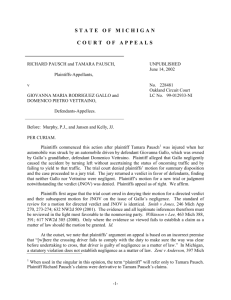
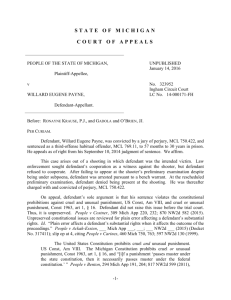
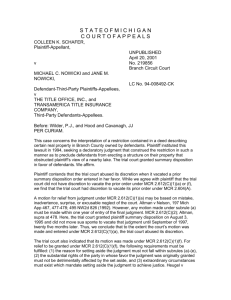
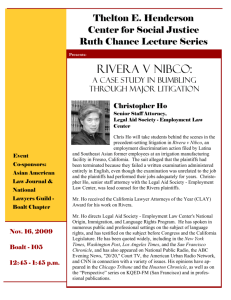
![[Click and Enter Attorney Name], State Bar No - E](http://s3.studylib.net/store/data/007177564_1-4d9407aff5e1ecb2a5922cd955484ee2-300x300.png)
